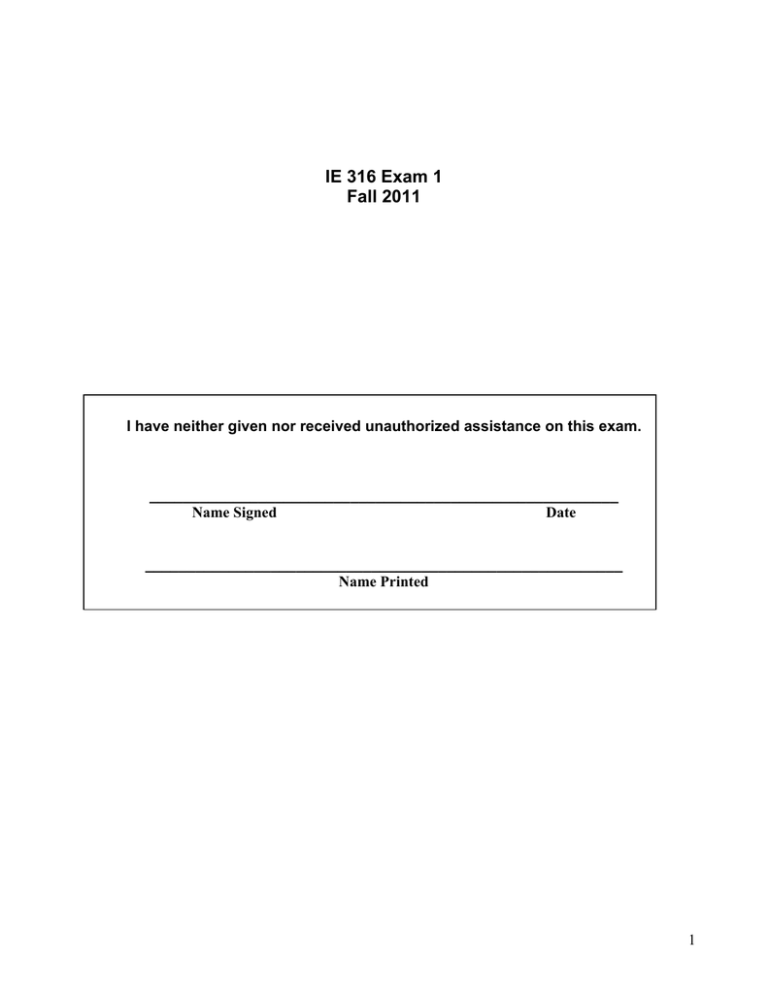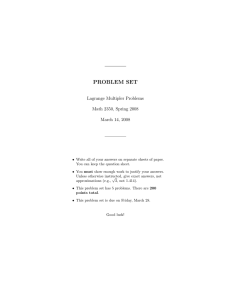IE 316 Exam 1 Fall 2011
advertisement

IE 316 Exam 1 Fall 2011 I have neither given nor received unauthorized assistance on this exam. ________________________________________________________ Name Signed Date _________________________________________________________ Name Printed 1 1. Suppose the actual diameters x in a batch of steel cylinders are normally distributed with mean x 2.5025 inch and standard deviation x .004 inch. Suppose further, that associated with the measurement of any cylinder is a measurement error independent of (a randomly selected) x and normal with mean 0 and standard deviation device .003 inch. ( is perhaps produced by small inconsistencies in how the measuring device is used and unavoidable/unpredictable small mechanical and electrical effects in the device.) 7 pts a) Modeling a measurement y (of a randomly selected cylinder) as y x exactly what probability distribution is appropriate for y ? (Name the distribution and give numerical values for its parameters.) 7 pts b) The modeling in a) (and, actually, all we've done in IE 361) ignores the fact that real measurement is digital (measurements are made only "to the nearest something"). Sometimes (not always) this is OK. But more careful modeling treats a digital measurement y* derived from y by "rounding to the nearest something" as discrete. In the present context, measurements to the nearest .01 inch might be described using the pmf below. Show how the probability for y* 2.50 was derived. Then compare the mean and standard deviation of y* to those of y (from a)) and x . y* f y* 2.52 .0062 2.51 .3023 2.50 .6247 2.49 .0666 2.48 .0002 2 2. See JMP Reports #1 attached at the end of this exam. They concerns some measurements made on the machined inside diameter of a single steel forklift wheel (units are inches) using a single gauge. Use the information on those reports in answering the following questions. (The 18 measurements together have sample mean 2.04748 inch and sample standard deviation .00343 inch.) 7 pts a) Consider first only the measurements made by Operators #1 and #2. Give 95% confidence limits for the difference in measurement biases for the two operators. 5 pts b) What would your interval from a) estimate if every measurement had been made on a different wheel produced by a stable production process (assuming that the two "gauge-operator" combinations constitute linear measurement devices)? Now consider the measurements from all 6 operators (on the single wheel). 6 pts c) Give 95% confidence limits for a repeatability standard deviation. 6 pts d) Give 95% confidence limits for the standard deviation of operator biases. 3 6 pts e) Under the one-way random effects model, the Operator-sample-means are from a normal 1 2 2 repeatability . If one computes the sample standard distribution with standard deviation reproducibility 3 deviation of the operator-sample-means here, one gets the value .003633 inch. Use this to make 95% 1 2 2 confidence limits for reproducibility . Say why your limits are (or are not) consistent with repeatability 3 your answer to d). 3. Suppose that in the context of Problem 2, the J 6 operators all measure a total of I 4 wheels m 3 times each and that JMP produces SSOperator 66.0 , SSPart Operator 45.0 and SSE 8.1 , all in units of 106 inch 2 . 12 pts a) Find approximate 95% confidence limits for the standard deviation of measurements that would be produced by a large number of operators each measuring the same wheel once each. (You may take as given that appropriate approximate degrees of freedom are ˆ 13 .) 4 5 pts b) If engineering specifications on the machined diameter are 2.0474 .005 inch, is the gauge in question adequate to check conformance to these specifications? Explain in terms of a GCR. 5 pts c) If it were possible to completely eliminate operator-to-operator variability in measurement, would the gauge in question be adequate to check conformance to the 2.0474 .005 inch specifications? Explain very carefully. 5 4. Visual inspection of garments is less than perfectly consistent. A company has many inspectors that work at removing imperfect clothing items from a production stream and classifying them as "seconds." To study inspector consistency, a particular test garment marked with ink that can be seen under ultraviolet light is repeatedly included in a stream of items submitted to the inspectors to see if it passes inspection. Results from 10 inspections by each of 5 inspectors (in terms of the fraction of times the garment was identified a second) are below. Use this information to answer the following questions. Inspector 1 .1 p̂ 2 .3 3 .4 4 0 5 .2 7 pts a) Is there clear evidence in these values of a consistent difference in how Inspectors #1 and #2 classify this garment? (Provide an argument based on an appropriate 95% confidence interval.) 9 pts b) What fraction of the variance in "perfect-vs-second" calls on this garment appears to be attributable to consistent differences between inspectors? 6 5. See JMP Reports #2 and #3 attached at the end of this exam. These concern regression analyses of some chemical analysis data taken from https://facultystaff.richmond.edu/~cstevens/301/Calibration6.html and listed below Concentration 0 10 20 30 40 50 60 Signal .006 .077 .138 .199 .253 .309 356 The data are (real) graphite furnace atomic absorption spectroscopy data concerning lead content of water samples. (The units of concentration were ppb and those of the signal were A-s.) The plotted limits are 95% prediction limits for the signal at each concentration. Subsequent to the calibration study represented by the data above, a tap water sample is measured as having signal value .278. 8 pts a) First use Report #2 and provide a single-number estimate of the lead content of the tap water and also 95% confidence limits for that measurand. 5 pts b) Report #3 is based on a quadratic (rather than simple linear) regression of signal on lead content. What single-number estimate of the lead content of the tap water sample does it provide? Does this differ substantially from your answer to a)? 5 pts c) In what practical way does the analysis on Report #3 differ from that on Report #2? (Do not say "one is linear and the other is quadratic." Instead tell me how the difference would affect what a user believes concerning lead content measurements.) What basic weakness of the data collection makes it impossible to tell which analysis actually makes the most sense here? 7 JMP Reports #1 8 JMP Report #2 9 JMP Report #3 10





